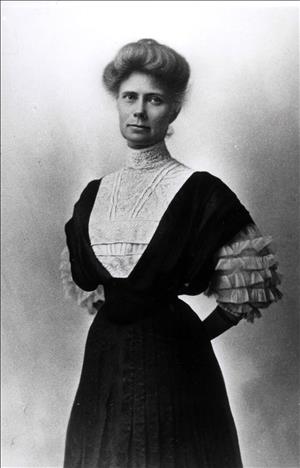On December 14, 1891, the Broadway School in Everett opens its doors to its first 26 students. It is a new building in a city that is not yet formally incorporated, but growing fast, and Emma Sarepta Yule (1863-1939) is the first teacher hired. A high school program starts the next year, with Margaret Clark as the first graduate in 1893. The student body multiplies from 26 to more than 150 in the first year. This means additional buildings – some built, some rented – more teachers, and a budding administrative bureaucracy. Yule is named the first principal and subsequently the first superintendent of the Everett School District, before losing both positions when the school board appoints men to fill those roles.
First Building, First Teacher
Sited at Broadway and Wall streets, the Broadway School was a wood frame building, 26 by 50 feet. It was planned for one story, but Henry Hewitt (1840-1918), president of the recently incorporated Everett Land Company, volunteered to pay for a second level, predicting that the student body would grow as workers joined new businesses. He was correct. Even with the additional room, the Broadway School was overflowing within months and the city had to rent additional space and hire a second teacher, Annette "Nettie" Boucher (1848-1912), in January 1892. Boucher and Yule were each paid $60 per month.
That February, Yule was appointed principal. Her tenure was short-lived. On July 4, 1892, the school board hired J. W. Shepherd (d. 1912) as the principal and demoted Yule to "the position next to principal." Yule stayed on, developing a number of innovative programs for Everett students and staying active in civic life. By 1897, Shepherd had left for Spokane, later serving as secretary of the state Board of Education.
Yule wanted students to get experience beyond basic subjects. One of her projects in her second year was to have students write accounts of their new town, some of which were published in editions of the Everett Times.
"Bessie Secrest, a little ten-year old Miss, wrote the following: '"Everett is composed of all kinds of inhabitants. It was divided into two parts but now it is all together. It is said to be the largest city on Puget Sound yet. It is also composed of log huts, tents, and about everything that you can sleep in. Everett is all stumps and mud about, for there’s nothing else hardly for it to be, for there are a great many trees here and men are trying to get them out if possible. Engineers are surveying all the land and staking it off. There are nothing here but boarding houses and stores. I would just as lieve they would take their saloons and run away" (Riddle).
Willie Powers, age 10, in an entry published on February 9, 1892, described one setback: "There is a sash and door factory. It had a load of machinery going down the river and it struck a boom and all the machinery went to the bottom of the river, and so the sash and door factory is not working any more" (Riddle).
Thomas Spencer (1877-1958), then 14, wrote that it was "wonderful to walk the streets of Everett and think just one year ago there were but one or two houses and now there are about seven or eight hundred." He described the development of the Pacific Steel Barge Company site on the Snohomish River, one of the first of the Everett Land Company's major projects: "The barge works is situated about half way between East Everett and the Bay. They have a fine place for the barge works. They have about one hundred men working at the steel barge works. They have a large hotel and a small store. They have two pile drivers driving piles and they want to get another. They have already got a large dock. They get most of their lumber from Tacoma. It is a horrible looking place now, but they will soon have it planked, and then it will be a beautiful place" (Riddle).
Following the Smokestacks
The "horrible looking place" was about to be the site of the Broadway School's twin building. Built by W. J. Miller in 1893, it was known as the Barge Works School, serving the children of the company's rapidly growing labor force. Ambrose Sherwood was hired to teach there. (An ardent teetotaler, and later a school superintendent, he also ran unsuccessfully for public office as part of the Prohibition Party.) The hiring boom was not to last. When the barge works shut down, a casualty of the Panic of 1893, the school lost many of its students. Eight years later it was moved to Marine View Drive. There it was renamed the Smelter School for the Puget Sound Reduction Company smelter that received the ore from the mining operation at Monte Cristo. As of 2022 the building still stands, now used as apartments.
Five years after its inaugural class, Everett School District had several buildings – two of them made of brick – 21 teachers, and 745 students. And it was about to have its first female superintendent.
Yule was elected superintendent on January 7, 1897, at a salary of $85 per month. She was re-elected to the position for the next three school years until, on July 23, 1900, the school board named George St. John superintendent in her stead. Demoted to principal of Everett High School, and then rebuffed when she petitioned for a raise in pay, Yule left in December 1900 to establish the new school district in Juneau, Alaska. During her time in Everett, the school system grew from those first 26 students to an average daily attendance of 1,032 in 1900.

